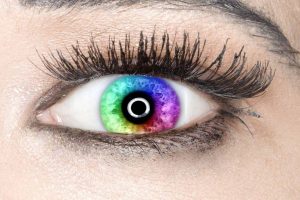Up to 15% of all children suffer with this eye condition.
Convergence insufficiency (CI) is a highly treatable binocular vision condition that affects near vision and eye muscle coordination. Convergence of the eyes occurs when the two eyes need to focus on a close object, such as a book, computer, tablet, smartphone, etc.
What is Convergence Insufficiency (CI)?
Convergence insufficiency means the eyes struggle to focus easily for near tasks, affecting school work, attention and office performance in adults.
A proper diagnosis of CI can prevent a child from being labelled as “lazy,” “spacey,” “clumsy”, “anxious,” and even misdiagnosed with ADHD, dyslexia, or mild autism.
How common is CI?
CI affects up to 1 in every 8 children, that is 13% of all school-aged students.
It is therefore possible, that four children in every classroom may be struggling with this condition!
Diagnosis and treatment of CI is essential for your child’s success in reading, learning, sports performance, and more.
What are the symptoms of CI?
There are many different symptoms that can develop as a result of CI— these are the most common:
- Eyestrain
- Headaches or muscle tension
- Blurred or double vision
- Difficulty reading and concentrating
- Uses finger or ruler when reading
- Avoidance of close work
- Poor hand-eye coordination
- Anxiety
- Motion sickness/dizziness
If your child has CI, the following tasks may be challenging:
- Homework
- Computer work
- Attention
- Reading
- Writing
- Comprehension
- Making crafts
Schedule an exam with an eye doctor who has experience diagnosing and treating CI with vision therapy, if you think that your child could be 1 of the 8 children affected by CI.
SEE RELATED: Do I Have Convergence Insufficiency?
How is CI diagnosed?
A comprehensive eye exam including specific analysis of visual skills, binocular vision, convergence and focusing is required to enable identification of CI.
A basic eye exam or screening with the 20/20 eye chart is not adequate for the detection of CI.
Why is CI often undetected?
Convergence insufficiency frequently goes undetected in school age children because comprehensive testing for CI is not included in pediatrician or school vision screenings, and standard eye exams conducted by ophthalmologists.
If an eye test does not include the specific tests mentioned above, this condition may remain undetected, affecting the child’s school and sports performances.
While the good news is that CI responds well to proper treatment— unfortunately, since many children are not assessed for CI, they are not getting the help they need early in life, if ever at all.
Children, teenagers and adults who remain undiagnosed and untreated tend to avoid reading and close work as much as possible or use various strategies to combat symptoms, such as using a ruler or finger to keep one’s place while reading or taking frequent breaks.
Can CI cause visual suppression?
If untreated, CI can lead to more serious eye problems such as lazy eye (amblyopia) or even an eye turn (strabismus).
If the convergence problems are left untreated, suppression can result. Suppression of vision in one eye occurs when the brain actively shuts off one eye, causing loss of binocular (two-eyed) vision and depth perception.
In this case, some or all of the following symptoms may present:
- Trouble catching balls and other objects thrown through the air
- Avoidance of sports and games that require accurate depth perception
- Frequent mishaps due to misjudgment of physical distances:
- Trips and stumbles on uneven surfaces, stairs, and curbs
- Frequent spilling or knocking over of objects
- Bumping into doors, furniture and other stationary objects
- Sports accidents
- Avoidance of eye contact
- Poor posture while doing activities requiring near vision
- Frequent head tilt
- Problems with motion sickness and/or vertigo
Contact a vision therapy eye doctor near you, if your child has experienced any of the above symptoms.
What is the best treatment for CI?
Vision therapy is the most effective treatment for CI.
Treatments for CI can be categorized as active or passive:
- Active treatment: A multi-site randomized clinical trial funded by the National Eye Institute called the Convergence Insufficiency Treatment Trial showed:
- The best treatment for CI is supervised vision therapy in a clinical office with home reinforcement (15 minutes of prescribed vision exercises done in the home five days per week).
- Children responded quickly to this treatment protocol
- 75% of all children achieved either full correction of their vision or saw marked improvements within 12 weeks.
- Passive treatment: Prismatic (prism) eyeglasses can be prescribed to decrease some of the symptoms.
- Although prism eyeglasses can relieve symptoms, they are not a “cure” and the patient typically remains dependent on the prism lenses.
- Adaptation problems can lead to the need for stronger prescriptions in the future.
Scientific research, as well as optometric and ophthalmological clinical trials, agree that the primary treatment of CI should be vision therapy.
Do pencil push-ups work?
Unfortunately, No.
Some ophthalmologists may still treat children with ‘pencil-push-ups’. While a 2002 survey of ophthalmologists and optometrists indicated that home-based pencil-push-ups therapy is the most common treatment, scientific research does not support this method.
Studies done on pencil push-ups have shown it to be ineffective in eliminating symptoms.
Vision therapy
Vision therapy is highly recommended for treatment of CI.
Standard eyeglasses, contact lenses, medications, and surgery will not be effective in treating the condition. Vision therapy focuses on training the eyes to work together to improve 3-D vision, depth perception, and clear binocular vision.
Treatment exercises for CI may include:
- Eye tracking with pursuits and saccades
- Focusing for near and distance
- Depth perception practice
- Specialized equipment and tools such as prisms and lenses
- Training with computerized technology
The goal of vision therapy is to stimulate the communication between the brain and eyes, to enable clear and comfortable vision at all times.
According to Dr. Michael J. Bartiss, O.D., M.D., F.A.A.O., F.A.A.P., F.A.C.S, Pediatric Ophthalmologist, “Fortunately, in most cases, convergence insufficiency is very amenable to orthoptics and vision therapy.”
If you think your child may have CI, schedule an eye exam to assess your child’s vision skills.
Recent published studies have shown that CI can be effectively treated.
LEARN MORE: Guide to Vision Therapy
An eye doctor near you can prescribe a customized vision therapy program, tailored to your child’s specific needs. Vision therapy can improve your child’s binocular vision— facilitating your child’s healthy development of many essential life skills.










